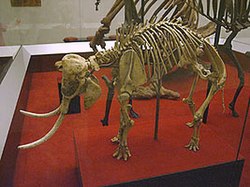Insular dwarfism

Insular dwarfism is the process and condition of the reduction in size of large animals - almost always mammals - when their gene pool is limited to a very small environment, primarily islands.
This effect has manifested itself many times throughout natural history, including with dinosaurs and modern animals such as elephants and human beings.
There are several proposed explanations for the mechanism which produces such dwarfism, which are often considered likely to be co-contributing factors, including an evolved gene-encoded response to environmental stress, as well as a selective process where only the smaller of the animals trapped on the island survive, as food declines to a borderline level. The smaller animals need fewer resources, and so are more likely to get past the break-point where population decline allows food sources to replenish enough for the survivors to flourish.
Examples
Among the most famous examples of insular dwarfism are:
- The Channel Islands Mammoth which lived on the prehistoric island of Santa Rosae in the California Channel Islands, and the small woolly mammoths of Saint Paul Island off Alaska, and Wrangel Island north of Siberia.
- Dwarf elephants in the recent natural history of Malta, Crete, Cyprus, and Sicily.
- Dwarf stegodons (elephant relatives) from the recent natural history of Flores, Sulawesi, Sumba and Timor.
- A (disputed) species of hominin called Homo floresiensis, from fossils found on Flores Island, Indonesia.
- Dinosaurs, including the recently validated Europasaurus, on Mesozoic islands such as Haţeg Island.
There are also proposed instances of this process occurring among plant life, the appearance of dwarf sequoia / redwood trees being one such proposal.[citation needed]
This process, and other "island genetics" artifacts, can occur not only on islands, but also in other situations where an ecosystem is isolated from external resources and breeding. This can include caves, desert oases, and isolated valleys. An example of this is the "pygmy" people of Africa, such as the Mbuti, who evolved a small size while in genetic and ecological isolation in a dense jungle region.
There is an inverse form of this process, island gigantism, wherein small animals, lacking the predators of their normal homes, may become "gigantic" when breeding in isolation. An excellent example is the dodo, the ancestors of which were normal-sized pigeons. Another process in the increase of body size occurs in cold regions of the Earth (see Bergmann's rule). Bigger bodies reduce the surface-to-mass ratio which reduces the loss of heat, so bigger bodies have advantages over smaller ones. Examples of this include the Siberian tiger, the largest living member of the cat family; the polar bear, the largest extant land carnivore; and the Emperor Penguin, the tallest and heaviest living penguin species.
Additional examples
- Channel Island fox in California, United States, and the enigmatic, nearly extinct Cozumel fox
- Honshū Wolf in Japan
- Bali Tiger
- Cozumel Island Raccoon
- Sardinian Dhole
- Sardinian lynx
- The strange, tiny Balearic Islands Cave Goat (Myotragus balearicus) in Majorca and Minorca and its close relative Nesogoral, from Sardinia which became extinct after human settlement
- Philippine water buffalo, Tamaraw, Anoa and other dwarf bovids from South East Asia
- Several prehistoric species of hippopotamus from the Pleistocene of Mediterranean islands (such as Phanourios minutis) and Madagascar
- Dwarf deer species on the Philippines (Philippine Sambar, extant), and Crete (Candiacervus ropalophorus), Ryukyu Islands of Japan (Cervus astylodon) and Gargano (Hoplitomeryx) (all extinct)
Other
- The tiny flightless Inaccessible Island and Laysan Rails
- The dwarf nodosaurid Struthiosaurus from Europe, and the dwarf allosaur from South Australia
